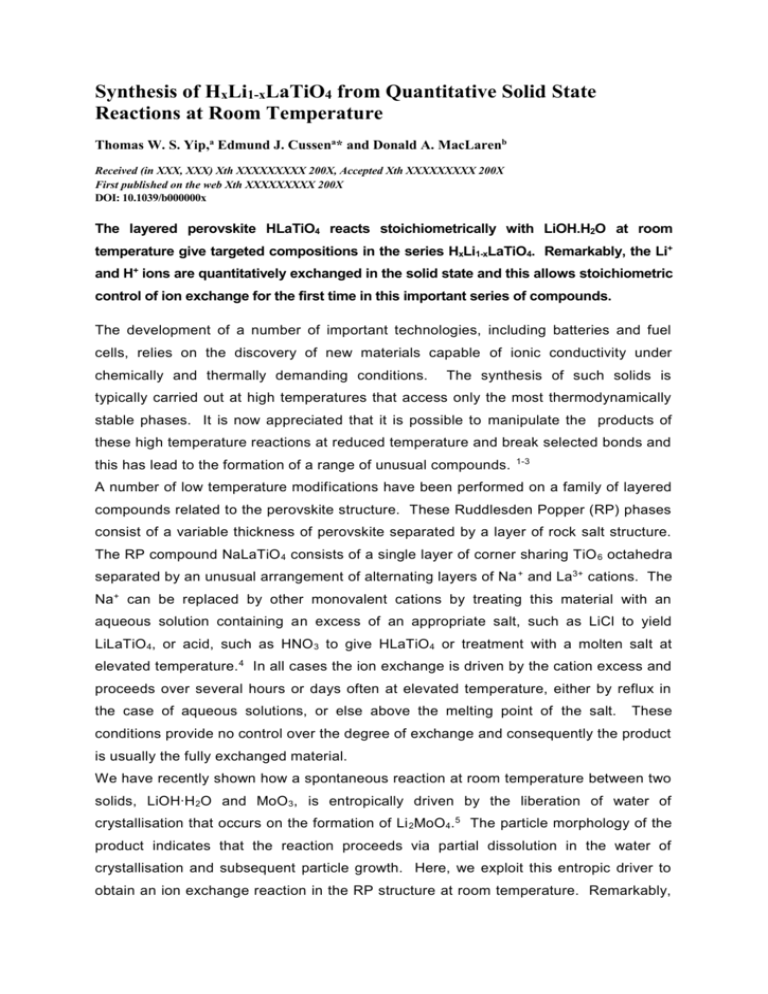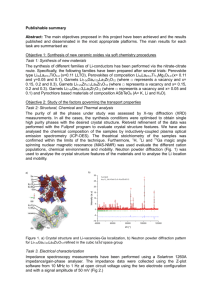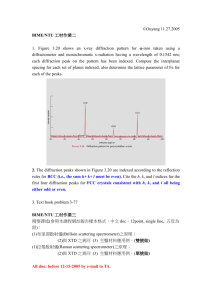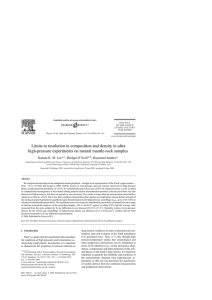EJCussen_B920837b_Text_Revised - Strathprints
advertisement

Synthesis of HxLi1-xLaTiO4 from Quantitative Solid State Reactions at Room Temperature Thomas W. S. Yip,a Edmund J. Cussena* and Donald A. MacLarenb Received (in XXX, XXX) Xth XXXXXXXXX 200X, Accepted Xth XXXXXXXXX 200X First published on the web Xth XXXXXXXXX 200X DOI: 10.1039/b000000x The layered perovskite HLaTiO4 reacts stoichiometrically with LiOH.H2O at room temperature give targeted compositions in the series HxLi1-xLaTiO4. Remarkably, the Li+ and H+ ions are quantitatively exchanged in the solid state and this allows stoichiometric control of ion exchange for the first time in this important series of compounds. The development of a number of important technologies, including batteries and fuel cells, relies on the discovery of new materials capable of ionic conductivity under chemically and thermally demanding conditions. The synthesis of such solids is typically carried out at high temperatures that access only the most thermodynamically stable phases. It is now appreciated that it is possible to manipulate the products of these high temperature reactions at reduced temperature and break selected bonds and this has lead to the formation of a range of unusual compounds. 1-3 A number of low temperature modifications have been performed on a family of layered compounds related to the perovskite structure. These Ruddlesden Popper (RP) phases consist of a variable thickness of perovskite separated by a layer of rock salt structure. The RP compound NaLaTiO 4 consists of a single layer of corner sharing TiO 6 octahedra separated by an unusual arrangement of alternating layers of Na + and La3+ cations. The Na+ can be replaced by other monovalent cations by treating this material with an aqueous solution containing an excess of an appropriate salt, such as LiCl to yield LiLaTiO 4, or acid, such as HNO 3 to give HLaTiO 4 or treatment with a molten salt at elevated temperature. 4 In all cases the ion exchange is driven by the cation excess and proceeds over several hours or days often at elevated temperature, either by reflux in the case of aqueous solutions, or else above the melting point of the salt. These conditions provide no control over the degree of exchange and consequently the product is usually the fully exchanged material. We have recently shown how a spontaneous reaction at room temperature between two solids, LiOH∙H 2O and MoO 3, is entropically driven by the liberation of water of crystallisation that occurs on the formation of Li 2MoO4.5 The particle morphology of the product indicates that the reaction proceeds via partial dissolution in the water of crystallisation and subsequent particle growth. Here, we exploit this entropic driver to obtain an ion exchange reaction in the RP structure at room temperature. Remarkably, the Li+ and H+ ions are quantitatively exchanged in the solid state whilst retaining particle morphology and crystallinity and so this demonstrates a fundamentally new reaction that exploits room temperature ionic conduction. This allows stoichiometric control of ion exchange for the first time in this important series of compounds. Moreover, this methodology should be generally applicable to the large number of related proton-containing RP phases and so may provide access to a library of new compounds. NaLaTiO4 was prepared via high temperature synthesis 6 from appropriate oxides and carbonates and treated with nitric acid 7 to give HLaTiO 4. This solid acid was reacted with one equivalent of hydrated lithium hydroxide, LiOH∙H 2O, by grinding at room temperature for 30 min. The powder mixture became less friable with grinding but did not become tacky or damp, despite the reaction generating two molar equivalents of water. X-ray powder diffraction data collected immediately after grinding showed that the basic structure of the Ruddlesden Popper phase had been retained and that the lattice parameters had undergone a substantial contraction to the values expected for LiLaTiO 4.8 Scanning electron micrographs show that this material has the same monolithic particle morphology as the HLaTiO 4 reagent and the NaLaTiO 4 precursor suggesting that Li + had been exchanged for H + without the dissolution or delamination of the perovskite layers that can occur in ion exchange. 9 The process was repeated using a reduced ratio of LiOH·H 2O to carry out the reactions [1]: HLaTiO 4 + x 7LiOH·H2O → H1-xLixLaTiO 4 + 2x H2O [1] This afforded a series of compounds that exhibited X-ray powder diffraction patterns that could be indexed using the same space group, P4/nmm, as HLaTiO 4 and LiLaTiO 4, but with a smooth evolution in lattice parameters between these compounds as shown in Figure 2. There was some reduction in crystallinity as shown by a ca. 70 % increase in the peak width but the data were still amenable to structural analysis. Neutron diffraction data were collected from H0.5Li0.5LaTiO 4 at room temperature using the constant wavelength diffractometer D2B at the Institute Laue Langevin in Grenoble. The data were fitted in the space group P4/nmm with a mixture of H + and Li+ in the interlayer galleries. The position of the hydrogen atom was fixed at coordinates derived from full refinement against neutron diffraction data collected from HLaTiO 4.10 The H/Li content was refined freely within the constraints of charge balance to the composit ion H0.46(2)Li0.54(2)LaTiO 4 that gave excellent agreement with the target stoichiometry. The final refinement constrained the composition to that of the reaction mixture to give the fit shown in Figure 3. The H + and Li+ cations are disordered in the interlayer space; the proton is disordered over eight positions around each of the apical oxide anions at a short distance, 1.03 Å, that is typical for protonated oxide. 11 The lithium cations are coordinated to four oxide anions at 2.0131(13) Å with a O-Li-O angle, 97.6°, that is intermediate between tetrahedral and square planar geometries. The peak widths of this phase show that the crystallinity is largely unaffected by the presence of a mixture of H + and Li+ in the interlayer space in H 0.5Li0.5LaTiO 4. Transmission electron microscope images of the sample support this observation and show no evidence for staged cation exchange. As shown in Figure 3 H0.5Li0.5LaTiO4 shows lattice fringes extending over > 10 nm indicating that this sample retains considerable crystallinity. It is known that heating HLaTiO 4 can lead to decomposition and dehydration to give an amorphous phase. 12 Thermogravimetric measurements show that H 0.5Li0.5LaTiO4 undergoes a large mass loss between 120 °C and 600 °C. xLixLaTiO 4 Heating the series H 1- gives a trend in mass loss that indicates that the dehydration reaction [2] is occurring. H1-xLixLaTiO 4 → LixLaTiO 4-x/2 + 1/2 (1-x) H2O [2] X-ray diffraction patterns collected from the dehydrated product obtained by heating the x = 0.5 compound to 480 °C, with the nominal composition Li 0.5LaTiO 3.75, show that some crystallinity is retained. These data can be indexed using a tetragonal cell with the substantial reduction in the interlayer distance that is anticipated to result from loss of interlayer protons and apical oxide anions. Although the structure of this phase is not known, it contains a mixture of Li+ and vacant sites that has strong similarities with the fast Li+ conducting perovskites Li 3xLa2/3-xTiO3.13, 14 Figure 4 shows preliminary analysis of the transport properties of Li 0.5LaTiO 3.75 with a total conductivity of 7.9(8)×10 -8 S cm-1 at 440 °C and an activation energy of 0.79(10) eV that are similar to those reported for the LiLaTiO 4 end member.8 Although this conductivity is orders of magnitude less than the perovskites, it may be that the grain boundaries are providing the limit to ion mobility. To conclude, a direct solid-state reaction at room temperature has produced a new series of compounds. The reaction occurs without dissolution and the only side -product of the reaction is water and so no purification, other than drying in air, is necessary. Given the wide-ranging stoichiometries and structure types observed for the protonated layered perovskite phases it is probable that this reaction will open up a huge range of new compositions that are inaccessible via existing synthetic routes. The authors are grateful to the Royal Society for the provision of a University Research Fellowship to EJC, to Scottish Universities Physics Alliance for providing DAM with a Fellowship and to the University of Strathclyde for funding and the Dr Emmanual Suard at the Institut Laue Langevin for assistance with neutron diffraction experiments. We also thank Dr Paul Edwards for collecting scanning electron micrographs and Mr James Morrow for assistance in collecting thermogravimetric data. Notes and references a WestCHEM, Department of Pure and Applied Chemistry, The University of Strathclyde, Thomas Graham Building, 295 Cathedral Street, Glasgow, G1 1XL Scotland Fax: (+44) 141 548 4822; Tel: (+44) 141 548 2797; E-mail: edmund.cussen@strath.ac.uk b Department of Physics and Astronomy, University of Glasgow, Kelvin Building, Glasgow, G12 8QQ Scotland † Electronic Supplementary Information (ESI) available: [Experimental procedures, diffraction patterns, thermogravimetric data and electron microscopy images are available]. See DOI: 10.1039/b000000x 1. M. S. Whittingham, Journal of the Electrochemical Society, 1976, 123, 315. 2. M. A. Hayward, E. J. Cussen, J. B. Claridge, M. Bieringer, M. J. Rosseinsky, C. J. Kiely, S. J. Blundell, I. M. Marshall and F. L. Pratt, Science, 2002, 295, 1882. 3. Y. Tsujimoto, C. Tassel, N. Hayashi, T. Watanabe, H. Kageyama, K. Yoshimura, M. Takano, M. Ceretti, C. Ritter and W. Paulus, Nature, 2007, 450, 1062. 4. R. E. Schaak and T. E. Mallouk, Chem. Mater., 2002, 14, 1455. 5. T. W. S. Yip, E. J. Cussen and C. Wilson, Dalton Transactions, 2009, accepted for publication. 6. G. Blasse, Journal of Inorganic and Nuclear Chemistry, 1968, 30, 656. 7. S.-H. Byeon, J.-J. Yoon and S.-O. Lee, Journal of Solid State Chemistry, 1996, 127, 119. 8. V. Thangadurai, A. K. Shulka, J. Gopalakrishnan, O. Joubert, L. Brohan and M. Tournoux, Materials Science Forum, 2000, 321-324, 965. 9. S. Ida, C. Ogata, M. Eguchi, W. J. Youngblood, T. E. Mallouk and Y. Matsumoto, Journal of the American Chemical Society, 2008, 130, 7052. 10. T. Y. Yip and E. J. Cussen, unpublished results. 11. G. Ferraris and G. Ivaldi, Acta Crystallographica, 1984, B40, 1. 12. V. Thangadurai, G. N. Subbanna and J. Gopalakrishnan, Chemical Communications, 1998, 1299. 13. J. A. Alonso, J. Sanz, J. Santamaria, C. Leon, A. Varez and M. T. Fernandez-Diaz, Angewandte Chemie-International Edition, 2000, 39, 619. 14. M. Yashima, M. Itoh, Y. Inaguma and Y. Morii, Journal of the American Chemical Society, 2005, 127, 3491. Figure Captions Fig.1 The crystal structures of the layered perovskite phases NaLaTiO4, HLaTiO4 and LiLaTiO4. TiO6 units are represented by red octahedra while black, orange, grey and yellow spheres represent La3+, Na+, H+ and Li+ respectively. Fig. 2 The lattice parameters and unit cell volume as a function of lithium content for the series H1-xLixLaTiO4 derived from X-ray powder diffraction data. The estimated standard deviations are smaller than the symbol size. Empy circles and squares represent data from repeating the reaction using a different sample of HLaTiO4 reagent. The solid black squares indicate literature values.[7] Fig. 3 The neutron powder diffraction profile collected from H0.5Li0.5LaTiO4 at room temperature at a wavelength, = 1.54 Å. The observed data are shown as dots and the calculated pattern is shown as a solid line. Allowed Bragg peaks are indicated by vertical bars. The inset shows the lattice fringes extending over > 10 nm observed using transmission electron microscopy. Fig. 4 The total conductivity of a sample of H0.5Li0.5LaTiO4 after heating above the dehydration temperature to give a compound of nominal stoichiometry Li0.5LaTiO3.75. The conductivity was derived from fitting AC impedance data as shown in the inset for data collected at 440 °C using the equivalent circuit shown.







